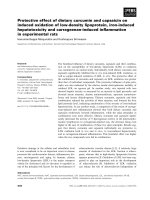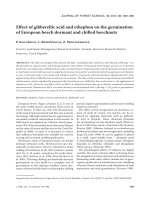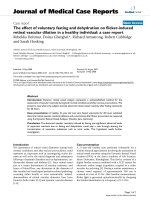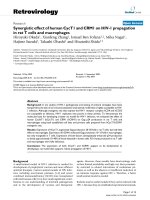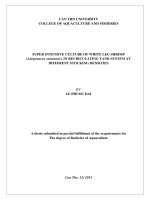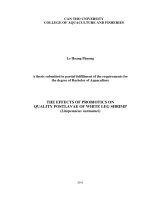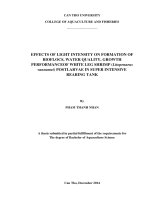Growth promoter effect of ginger, garlic and fenugreek on Pacific white leg shrimp (Litopenaeus vannamei)
Bạn đang xem bản rút gọn của tài liệu. Xem và tải ngay bản đầy đủ của tài liệu tại đây (321.02 KB, 9 trang )
Int.J.Curr.Microbiol.App.Sci (2019) 8(2): 2993-3001
International Journal of Current Microbiology and Applied Sciences
ISSN: 2319-7706 Volume 8 Number 02 (2019)
Journal homepage:
Original Research Article
/>
Growth Promoter Effect of Ginger, Garlic and Fenugreek on
Pacific White Leg Shrimp (Litopenaeus vannamei)
R. Mahesh Kumar, A. Chandra Sekhara Rao, Narshivudu Daggula*,
Ganesh Guguloth, B. Yesu Das and Ashok Indhuri
College of Fishery Science, Muthukuru, Andhra Pradesh, India
*Corresponding author
ABSTRACT
Keywords
Litopenaeus
vannamei, Growth
promotor,
Supplemented diets
ginger, Garlic and
fenugreek
Article Info
Accepted:
22 January 2019
Available Online:
10 February 2019
The present study was carried out to understand the dietary ginger, garlic and fenugreek on
growth performance on Litopenaeus vannamei L. Vannamei was fed with three different
herbal powder of ginger, garlic and fenugreek of varying levels of 1%, 2.5%, 5%, 2%, 4%,
6%, 0.5%, 1% and 1.5% of concentrations respectively to assess the optimal growth
promoting potential. The feeding trial was continued for 63 days with triplicates in each
treatment. The growth parameters (ABW, weight gain, SGR), feed efficiency parameters
(FCR) and survival rate were significantly (P<0.01) higher in treatment diets fed L.
vannamei compared to control diet. Highest weight gain was observed in Garlic powder
4% supplemented diet compared to all other garlic supplemented diets. Growth measured
as specific growth rate was improved with the herbal supplementation in the basal diets.
The elevation in the SGR is in the order of garlic > ginger > fenugreek > control. It was
found that GP 4% supplementation in the diet was optimal level of inclusion in garlic
supplementation for L. vannamei culture. The diet supplemented with GP 4% fed L.
vannamei was showed best FCR with higher significance (P <0.01) compared to other
treatments.
Introduction
Globally aquaculture production has become
the rapid growing food production sector. It
provides high-quality animal protein with
total global production increasing from 63.6
million tonnes in 2011 to 66.63 million tonnes
in 2012 (FAO). For high production people
are started to incorporate antibiotic growth
promoters in feed. But due to its negative
impacts (residual accumulation in fish tissue,
emergence of antibiotic resistant microbes)
natural compounds are more acceptable to the
public. The herbal immunostimulants which
have been reported to enhance efficiency of
feed utilization and animal productive
performance (Levis et al., 2008). The herbal
plants have a wide variety of properties such
as:
antioxidant,
antimicrobial,
anticarcinogenic, analgesic, insecticidal,
antiparasitic, anticoccidial, growth promoters,
appetite enhancement, stimulant of secretion
of bile and digestive enzyme activity,
laxatives and antidiarrhea, hepatoprotection
(Coutteau et al., 2011).
2993
Int.J.Curr.Microbiol.App.Sci (2019) 8(2): 2993-3001
Garlic, Allium sativum L., has been used for
the treatment of many diseases since ancient
times as reported in the Codex Ebers (1550
BC) where an Egyptian medical papyrus
described several therapeutic formulas based
on the garlic as a useful remedy for a variety
of diseases such as heart problems, headache,
bites, worms and tumors. Garlic (Allium
sativum) has several beneficial effects for
human and animals, exhibiting antimicrobial,
antioxidant, and antihypertensive properties
Sivam (2001). Garlic can help in the control
of pathogens, especially bacteria and fungi,
and increase the welfare of fish (Corzo,
2007).
Ginger (Zingiber officinalis) belongs to
Zingiberaceae family. The part of the plant
used is the rhizome, an important spice. The
use of spices as food and feed additives has
been practiced widely since ancient times. Till
date, no study has been carried out on the
shrimp with Z. officinalis as an herbal
appetizer. Therefore, in the present study, Z.
officinalis was chosen and the stimulatory
effect verified. Various percentages of Z.
officinalis was prepared and fed to postlarvae
(PL-1–30) of Penaeus monodon through the
live feed Artemia franciscana, because of its
versatile characteristics, such as taste, high
nutritive value, non selecting filter-feeding
capability and non-contamination of the
culture water. Ginger increases the pancreatic
and intestine lipase (Platel and Srinivasan,
2000).
Fenugreek (Trigonella foenumgraecum) is an
annual herb that belongs to the family
Leguminosae widely grown in Pakistan,
India, Egypt, and Middle Eastern countries
(Alarcon-Aguilara et al., 1998). Fenugreek
has also been reported to exhibit
pharmacological properties such as antitumor,
antiviral, antimicrobial, anti-inflammatory,
hypotensive and antioxidant activity (Cowan
et al., 1999 and Shetty et al., 1997).
Materials and Methods
Litopenaeus vannamei (1000 numbers) were
obtained from CP Hatchery, Nellore. Shrimp
seed were packed in double plastic bags filled
with oxygen and water in the ratio of 3:1 in
each bag and the density of shrimp was
300/bag. Post larvae (PL10) transported by
road in plastic bags containing 15 ppt saline
water. PL transferred to the same salinity
water in cement tanks of the wet lab.
Acclimatization was carried out over 10 days.
During this period the seed were fed apparent
satiation with control diet. The number of
shrimp seed to be packed in oxygen inflated
polythene bags was calculated as per the
following formula (Jameson et al., 1995). N =
(DO – 2) X V/CH Where: DO: Dissolved
oxygen content of water (mg/l), V: Volume of
water used for transport (Lt), C: Rate of
oxygen consumption of shrimp (ml/kg of
shrimp), H: Duration of transport (Hours)
Experimental design
The aquarium tanks used for experiments
were of size 60x30x30 cm (Plate 3). Thirty
aquariums including control were stalked on
iron racks. Aquariums were located in a
secured place where there is no direct sunlight
and covered all the sides with black paper to
avoid algal growth in the tank. Water in the
aquariums was aerated by using air stones
connected to the air compressor. Filters are
used for filtering the aquarium water. The
underground water was taken into a tank and
allowed to aerate for 48 hours and was used
for filling the aquaria. Salinity was checked
before taking the water into aquarium. The
water is allowed to pass through biofilter filter
for 24 hours before introducing the shrimps
into the aquaria. In each aquarium 12
numbers of shrimps with initial average
weights of 3.2±0.11gm were introduced and
triplicates were maintained for each
treatment. Regular water exchange of 25%
2994
Int.J.Curr.Microbiol.App.Sci (2019) 8(2): 2993-3001
was done every day. Left over feed, excreta
and other debris was siphoned off from the
bottom of the tank without disturbing the
shrimps at every 2 hours.
Experimental feed preparation and feeding
Garlic, ginger and fenugreeks were purchased
in sufficient quantities from local market. The
ingredients were sun dried for 2 weeks and
powdered at required quantities before feed
preparation. Ten experimental diets (Plate 8)
were prepared by supplementing a basal
formulated diet with different levels 0%
(Control), 2%, 4%, 6%, 1%, 2.5%, 5%, 0.5%,
1% and 1.5% of garlic, ginger and fenugreek
powders respectively. The growth parameters
of all the shrimps of each aquarium were
individually estimated by taking their total
body length and weight at 7 days interval.
Weight gain
Weight increment was obtained by
subtracting initial body weight from the final
body weight. Weight gain (gm) = Final body
weight (gm) – Initial body weight (gm).
Specific growth rate
Specific growth rate was calculated by the
formula
[(Ln FBW - Ln IBW) / day] x 100
FBW -IBW -Ln -Day --
Final body weight
Initial body weight
Logarithm
duration of experiment (63 days)
Results and Discussion
Growth of L. vannamei fed with garlic
powder (GP) supplementation
Observations on the growth during the first
week (7th day) revealed that weight gain
varied between 0.9±0.05g and 1.25±0.12g for
treatment GP 2% and GP 4% respectively.
Highest and lowest average weight values
were observed in the treatments GP 4%
(4.45±0.04g) and GP 2% (4.1±0.11g). On the
14th day highest weight gain of 1.22±0.07g
and lowest weight gain of 0.8±0.03g were
recorded for the GP 6% and control
respectively. Highest average weight values
(5.57±0.12g) and lowest average weight
values (5.1±0.04g) were recorded for GP 4%
and control respectively during the second
sample (14th day). On the 21st day the highest
and lowest weight gain observed were
0.92±0.06g and 0.51±0.10g for GP 4% and
GP 6% respectively, while the highest and
lowest average weight values observed were
(6.49±0.04g and 5.67±0.02g) for GP 4% and
GP 6% respectively. During the 28th day, the
highest and lowest weight gain observed were
1.25g±0.11g and 0.95±0.11g for GP 4% and
GP 6% respectively. The highest and lowest
average weight values observed were
(7.74±0.01g and 6.62±0.07g) for GP 4% and
GP 6% respectively. On the 35th day of the
experiment Highest and lowest weight gain
observed were 0.8±0.04g and 0.2±0.01g for
GP 6% and GP 4% respectively. The highest
and lowest average weight values observed
were (7.94±0.05g and 7.32±0.04g) for GP 4%
and control respectively. GP 2% and GP 6%
stood in second and third positions with
weight of 7.85±0.01g and 7.42±0.11g
respectively. On the 42nd day highest weight
gain of 1.15±0.07g and lowest weight gain of
0.75±0.02g were recorded for the GP 4% and
GP 6% respectively. Highest average weight
values 9.09±0.08g and lowest average weight
values 8.17±0.07g were recorded for GP 6%
and control respectively (Fig. 1).
On the 49th day highest weight gain of
0.75±0.01g and lowest weight gain of
0.31±0.03g were recorded for GP 4% and
control respectively. Highest average weight
values 9.84±0.07g and lowest average weight
2995
Int.J.Curr.Microbiol.App.Sci (2019) 8(2): 2993-3001
values 8.48±0.03g were recorded for GP 4%
and control respectively. Highest average
weight values of 11.97±0.07g from GP 4%
and lowest average weight values of
9.55±0.07g from control were observed at the
end of the experiment. An overall study
indicated that the GP 4% recorded ABW of
11.97±0.07g in the 63 days’ experimental
period. This was followed by the GP 2%
(10.68±0.04g), GP 6% (9.70±0.05g) and
control (9.55±0.07g) they stood in second,
third and fourth positions respectively.
The use of spices as dietary supplements has
been practiced widely since time immemorial.
Apart from enhancing the palatability of feed,
herbal supplements have been widely
believed to exert digestive stimulant action
and growth promotion (venkataramalingam et
al., 2007).
The weight gain attained in GP 4% treatment
diet fed L. vannamei was also significantly (P
< 0.01) higher compared to other treatment
diets. Poongodi et al., (2012) were reported
similar increase in weight gain of M.
rosenbergii PL in the experimental diets over
control. Similar results with garlic
supplementation at 5% concentration were
obtained by Rebecca and Bhavan (2014) in
M. rosenbergii. Labrador et al., (2016) were
observed highest weight gain in L. vannamei
fed with diet containing 6% garlic powder.
The enhanced growth rate of the treatment
groups may be attributed to the growth
promoting substances present in the garlic
powder. The growth data was subjected to
analysis of variance (ANOVA) at 1% and 5%
level of significance. The statistical analysis
has shown that F- value is found to be
significant among treatments. Since F- value
is found to be significant, the pair wise
comparison of any two Treatments could be
done by computing RBD two way
classification. The Treatment GP 4% is found
to be significantly superior when compare to
other Treatments. Treatment GP 4% has
shown significantly different from all other
Treatments. The second and third positions
were occupied by GP 2% and GP 6%
respectively. There was a significant
difference between the culture periods also.
Highest weight gain in L. vannamei was
noticed in the GP 4% herbal supplemented
diets treatment compared to other treatments
throughout experimental period performance
related to progressive increase of garlic
concentration was found to be significant (P
<0.01) among treatments. The growth
promoting potential of several herbs on
aquatic animals has been tested by many
workers. The results were correlated with the
observations in the present study (Chitrasu et
al., 2002).
Growth of L. vannamei fed with different
concentrations
of
ginger
powder
supplementation
Observations on the growth during the first
week (7th day) revealed that weight gain
varied between 0.91±0.06g and 1.24±0.11g
for treatment ZP 1% and ZP 2.5%
respectively. Highest and lowest average
weight values were observed in the treatments
ZP 2.5% (4.44±0.05g) and ZP 1%
(4.11±0.10g). On the 14th day highest weight
gain of 1.12±0.10g and lowest weight gain of
0.7±0.07g were recorded for the ZP 1% and
ZP 5% respectively. Highest average weight
values (5.48±0.07g) and lowest average
weight values (5.09±0.07g) were recorded for
ZP 2.5% and ZP 5% respectively during the
second sample (14th day). On the 21st day The
highest and lowest weight gain observed were
0.94±0.04g and 0.42±0.02g for ZP 2.5% and
ZP 1% respectively, while the highest and
lowest average weight values observed were
(6.42±0.10g and 5.65±0.04g) for ZP 2.5% and
ZP 1% respectively. During the 28th day, the
highest weight gain observed were
2996
Int.J.Curr.Microbiol.App.Sci (2019) 8(2): 2993-3001
1.15±0.12g in ZP 1% and control. The lowest
weight gain observed were 0.65±0.01g for ZP
2.5%. The highest and lowest average weight
values observed were (7.07±0.05g and
6.66±0.02g) for ZP 2.5% and ZP
5%respectively. On the 35th day of the
experiment Highest and lowest weight gain
observed were 1.14±0.10g and 0.41±0.04g for
ZP 1% and control respectively. The highest
and lowest average weight values observed
were (8.02±0.02g and 7.32±0.04g) for ZP
2.5%% and control respectively. ZP 1% and
ZP 5% stood in second and third positions
with weight gain of 7.9±0.02g and 7.62±0.04g
respectively.
On the 42nd day highest weight gain
0.91±0.10g and lowest weight gain
0.35±0.01g were recorded for the ZP 2.5%
and ZP 1% respectively. Highest average
weight values 8.93±0.04g and lowest average
weight values 8.17±0.07g were recorded for
ZP 2.5% and control respectively. On the 49th
day highest weight gain 0.9±0.08g and lowest
weight gain 0.22±0.03g were recorded for ZP
2.5% and ZP 1% respectively. Highest
average weight values 9.83±0.07g and lowest
average weight values 8.48±0.03 were
recorded for ZP 2.5% and control
respectively. On the 56th day highest weight
gain 1.11±0.11g and lowest weight gain of
0.82±0.06g were recorded for ZP 2.5% and
control respectively.
Highest average weight values 10.94±0.08g
and lowest average weight values 9.3±0.06g
were recorded for ZP 2.5% and control
respectively. Highest average weight values
of 11.79±0.02g from ZP 2.5% and lowest
average weight values of 9.55±0.07g from
control were observed at the end of the
experiment. An overall study indicated that
the ZP 2.5% recorded ABW of 11.79±0.02g
in the 63 days experimental period. This was
followed by the ZP 5% (10.1±0.08g), ZP 1%
(9.95±0.03g) and control (9.55±0.07g) they
stood in second, third and fourth positions
respectively.
The statistical analysis has shown that Fvalue is found to be significant among
treatments. Since F- value is found to be
significant, the pair wise comparison of any
two Treatments could be done by computing
RBD two way classification. The Treatment
ZP 2.5% is found to be significantly superior
when compare to other Treatments. Treatment
ZP 2.5% has shown growth performance
significantly different from all other
Treatments. The second and third positions
were occupied by ZP 5% and ZP 1%
respectively. There was a significant
difference between the culture periods also.
Ginger place very important role in fat
digestion and adsorption (Platel and
Srinivasan, 2000). In the present study growth
performance through elevation in the average
weight and weight gain were showed
fluctuating trends with the progression of
experimental period. Highest average weight
(11.79±0.02g) weight gain (1.24±0.11g) were
observed in L. vannamei fed with the ZP
2.5% supplemented diets among all
treatments. Ginger supplemented diets were
demonstrated better growth performance
compared to control throughout experimental
period (Figure 2). It was noticed that ZP 2.5%
supplemented diets performed highest
significance (P <0.01) in the elevation of
growth in L. vannamei compared to all the
treatments. The growth performance in L.
vannamei fed with ginger supplemented diets
may be attributed to the growth stimulants,
enhanced digestive enzymes activity present
in herbs and P. monodon post larvae when fed
with pepain constituent of papaya leaf were
showed increase in weight gain (Penaflorida,
1995). Kesavnath and Jayaram (2000)
reported an improvement in the growth of M.
rosenbergii with the supplementation of
Nutripro-aqua, a soya based herbal product.
Ginger (100%) enriched artemia fed P.
2997
Int.J.Curr.Microbiol.App.Sci (2019) 8(2): 2993-3001
monodon PL was showed the highest weight
gain (130.8±1.7mg) compared to non
enriched artemia treatment (74.8±2.0mg)
(Venkataramalingam et al., 2007). Rebecca
and Bhavan (2014) were also reported
Z.officinale improved feed intake and
promoted the growth in the PL of M.
rosenbergii. El-Desouky et al., (2012) were
noticed similar results on the effect of
Z.officinale on the growth of M. rosenbergii.
(Chang et al., 2012) were observed similar
weight gain increase with the consequential
increase of zingerione in L. vannamei
juveniles. Similar growth performance in
aquatic organism with the inclusion of ginger
in the feed was reported by earlier workers
(Poongodi et al., 2012 and Rahimi et al.,
2015).
Growth of L. vannamei fed with different
concentrations of fenugreek powder
supplementation
Observations on the growth during the first
week (7th day) revealed that weight gain
varied between 1.18±0.12g and 0.82±0.04g
for treatment FP 1% and FP 0.5%
respectively. Highest and lowest average
weight values were observed in the treatments
FP 1% (4.38±0.04g) and FP 0.5%
(4.02±0.07g). On the 14th day highest weight
gain of 1.35±0.12g and lowest weight gain of
0.8±0.03g were recorded for the FP 1.5% and
control respectively. Highest average weight
values (5.6±0.02g) and lowest average weight
values (5.10±0.11g) were recorded for FP 1%
and control respectively during the second
sample (14th day). On the 21st day The highest
and lowest weight gain observed were
1.1±0.10g and 0.52±0.02g for FP 1% and FP
0.5% respectively, while the highest and
lowest average weight values observed were
(6.7±0.08g and 5.76±0.05g) for FP 1% and
control respectively. During the 28th day, the
highest and lowest weight gains observed
were 1.15±0.12g and 0.42±0.02g for control
and FP 1% respectively. The highest and
lowest average weight values observed were
(7.12±0.01g and 6.64±0.07g) for FP 1% and
FP 0.5% respectively. On the 35th day of the
experiment Highest and lowest weight gain
observed were 1.26±0.12g and 0.41±0.04g for
FP 0.5% and control respectively. The highest
and lowest average weight values observed
were (8.2±0.04g and 7.32±0.04g) for FP 1%
and FP 0.5% respectively (Fig. 3).
On the 42nd day highest weight gain
0.85±0.01g and lowest weight gain
0.45±0.01g were recorded for the control and
FP 1.5% respectively. Highest average weight
values 8.85±0.07g and lowest average weight
values 8.16±0.05g were recorded for FP 1%
and FP 1.5% respectively. On the 49th day
highest weight gain 1.13±0.14g and lowest
weight gain of 0.31±0.03g were recorded for
FP 1% and control respectively.
Highest average weight values 9.98±0.12g
and lowest average weight values 8.48±0.03g
were recorded for FP 1% and control
respectively. On the 56th day highest weight
gain 0.92±0.10g and lowest weight gain of
0.75±0.12g were recorded for FP 1.5% and
FP 0.5% respectively. Highest average weight
values 10.86±0.02g and lowest average
weight values 9.3±0.06g were recorded for FP
1% and control respectively. Highest average
weight values of 11.35±0.03g from FP 1%
and lowest average weight values of
9.55±0.07g from control were observed at the
end of the experiment. An overall study
indicated that the FP 1% recorded ABW of
11.35±0.03g in the 63 days experimental
period. This was followed by the FP 1.5 %
(11.07±0.08g), FP 0.5 % (10.05±0.02g) and
control (9.55±0.07g) they stood in second,
third and fourth positions respectively.
Fig.1 Growth of L. vannamei fed with different concentrations of garlic powder supplementation
2998
Int.J.Curr.Microbiol.App.Sci (2019) 8(2): 2993-3001
14
12
10
8
6
4
2
0
Initial
7
14
21
Control
28
Garlic 2%
35
Garlic 4%
42
49
56
63
Garlic 6%
Fig.2 Growth of L. vannamei fed with different concentrations of ginger powder
supplementation
14
12
10
8
6
4
2
0
Initial
7
14
21
Control
28
35
Ginger 1%
Ginger 2.5%
42
49
56
63
Ginger 5%
Fig.3 Growth of L. vannamei fed with different concentrations of fenugreek powder
supplementation
12
10
8
6
4
2
0
Initial
7
14
Control
21
28
Fenugreek 0.5%
The growth data was subjected to analysis of
35
Fenugreek 1%
42
49
Fenugreek 1.5%
56
63
variance (ANOVA) at 1% and 5% level of
2999
Int.J.Curr.Microbiol.App.Sci (2019) 8(2): 2993-3001
significance. The statistical analysis has
shown that F- value is found to be significant
among treatments. Since F- value is found to
be significant, the pair wise comparison of
any two Treatments could be done by
computing RBD two-way classification. The
Treatment FP 1% is found to be significantly
superior when compare to other Treatments.
Treatment FP 1% has shown significantly
different from all other Treatments. The
second and third positions were occupied by
FP 1.5% and FP 0.5% respectively. There was
a significant difference between the culture
periods also. Growth performance of L.
vannamei fed with different concentration of
fenugreek powder supplementation. The
results in the present study were correlated
with the earlier observations in M. rosenbergii
(Poongodi et al., 2012), in Cyprinus carpio
(Roohi et al., 2015). Growth stimulants,
antioxidants, vitamins and minerals present in
fenugreek may have contributed for the
increase in weight gain of L. vannamei fed
with herbal supplemented diets. Growth
performance came to stand still or reduction
from the 1% FP inclusion level in the diet
may be due to reduction in palatability of the
feed.
References
Chang, Y., C. Liu, C. Wu, C. Chiang, J. Lian
and S. Hsieh, 2012. Dietary
administration of zingerone to
enhance growth, non-specific immune
response and resistance to Vibrio
alginolyticus in Pacific white shrimp
(Litopenaeus vannamei) juveniles.
Fish and Shellfish Immunol., 32: 284290.
Chitarasu TK, Babu MM, Sekar RJR, Marian
MP (2002) Developing Artemia
enriched herbal diet for producing
quality larvae in Penaeus monodon
(Fabricius). Asian Fish Sci 15:21–32
Corzo-Martinez M, Corzo N, Mar Villamiel.
Biological properties of onions and
garlic, Trends in Food Science &
Technology, 2007; 18:609-625.
Coutteau P., Ceulemans S., Halteren van
Alexander: Botanical extracts improve
productivity and economics in
aquaculture, Nutrad International,
Belgium, 2011.
Cowan, M. M. (1999). Clin. Microbiol. Rev.,
12: 564.
El-Desouky, H., El-Asely, A., Shaheen, A.A.
and Abbass, A., 2012. Effects of
Zingiber
officinalis
and
Cyanodondactylon on the growth
performance and immune parameters
of Macrobrachium rosenbergii, World
Journal of Fish and Marine Sciences,
4(3): 301-307.
FAO. The State of World Fisheries and
Aquaculture. FAO Fisheries and
Aquaculture Department, Rome, Italy,
2014, 200.
Keshavanth, P. and Jayaram, K.E. (2000).
Growth Response of the Giant
Freshwater Prawn, Macrobrachium
rosenbergii
to
Feed
Additive,
Nutripro-aqua.
The
5th
Asian
Fisheries Forum, Book of Abstracts,
Fisheries and Food Security Beyond
the Year 2000, Bangkok, Thailand.
Labrador, Recamar C. Guinares and Gaily
jubie S. Hontiveros effect of garlic
powder supplementation diets on the
growth and survival of pacific white
leg shrimp (Litopenaeus vannamei),
Animal husbandry and veterinary
science research article.
Levic J, Sinisa M, Djuragic O, Slavica S.
Herbs and organic acids as an
alternative for antibiotic- growthpromoters. Archiva Zootechnica.
2008; 11:5-11.
Penaflorida, V.D. (1995) Effect of papaya leaf
meal on the Penaeus monodon post
larvae, Israeli. J. Aquac. Bamidgeh,
47, 25–33.
3000
Int.J.Curr.Microbiol.App.Sci (2019) 8(2): 2993-3001
Platel, K. and K. Srinivasan, 2000. Influence
of dietary spices and their active
principles on pancreatic digestive
enzymes in albino rats. Nahrung, 44:
42-6.
Poongodi,
R.,
Saravanabhavan,
P.,
Muralisankar, T., and Radhakrishnan,
S. (2012). Growth promoting potential
of garlic, ginger, turmeric and
fenugreek on the freshwater prawn
Macrobrachium
rosenbergii.
International Journal of Pharma and
Bio Sciences, 3, 914–926.
RahimiYadkoori, Nasrin; Zanguee, Nasim
Mousavi, Seyed Mohammad*; Zakeri,
Mohammad Effects of Ginger
(Zingiber officinale) Extract on
Digestive Enzymes and Liver Activity
of
Mesopotamichthys
sharpeyi
Fingerlings Journal of the Persian Gulf
(Marine Science)/Vol. 6/No. 19/March
2015/10/1-10.
Rebecca, A.A. and P.S. Bhavan, 2011.
Growth
performance
of
Macrobrachium rosenbergii post
larvae fed with vegetable wastes and
palmolein supplemented formulated
feeds. Rec. Res. Sci. Tech., 3: 69-76.
Shetty, K. (1997). Asia. Pac. J. Clin. Nutr., 21
(1997) 79.
Sivam G.P. Recent advances on the
nutritional effects associated with the
use of garlic as supplement. Am. Soc.
Nutr. Sci, 2001, 1106-8.
Venkataramalingam, K., Godwin, C.J. and
Citarasu
T.
(2007).
Zingiber
officinalis, an herbal appetizer in the
tiger shrimp Penaeus monodon
(Fabricius) larviculture. Aquaculture
Nutrition 13 (6): 439-443.
How to cite this article:
Mahesh Kumar, R., A. Chandra Sekhara Rao, Narshivudu Daggula, Ganesh Guguloth, B. Yesu
Das and Ashok indhuri. 2019. Growth Promoter Effect of Ginger, Garlic and Fenugreek on
Pacific White Leg Shrimp (Litopenaeus vannamei). Int.J.Curr.Microbiol.App.Sci. 8(02): 29933001. doi: />
3001


